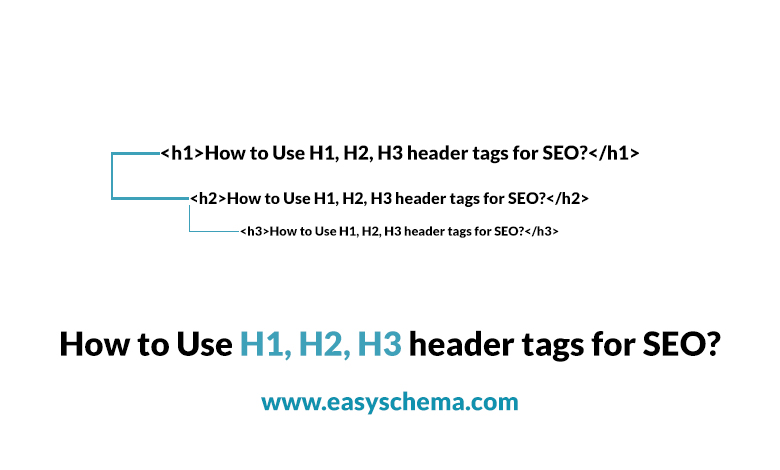If you want to grow traffic organically, you have to use SEO. Now you may wonder, how helpful are H1, H2, H3 header tags for SEO?
Even though these tags may show mixed results, higher in
SERPs, you should know that they are highly valuable to your content.
In early 2000, these heading elements were actual ranking factors. H1, H2, H3 are considered HTML elements and represent the levels of section headings (from the highest section level to the lowest). These heading tags are used to separate heading and subheadings on a website.
How can you use H1, H2, and H3 tags for SEO?
To better understand these elements, consider them as ranks of duty where H1 tags are most important, H2, etc. In this way, each subheading provides different information but relates to the main topic. You can use short-tail and long-tail keywords for search engines to pick them up.
Proper headings don’t have a huge impact on SEO alone. However, they do have many perks and benefits.
For example, the more direct the headings are, the better their value to the readers. As much as you need the content to be delivered, you have to make titles simple and easy to understand.
As you probably know, when people search for a subject, they look for direct answers. That’s why it is highly important to be precise and straightforward. On the other hand, people bore easily, so if you add useless information to your writing or revolve around a topic without getting to the point, they will move on.
But what do H1, H2, and H3 tags do?
An H1 tag contains the target keywords for a post and is the first impression people get when they spot an article in Google or other search engines. In addition, an H1 tag must state what the reader will learn from your article.
H1 tags tell the readers the actual subject matter, and that’s why you must deliver content directly relating to that topic (you don’t want your information to be misleading and incorrect).
Note: Use H1 tags to showcase everything that people can get after clicking on your title. Also, keep in mind that all your main keywords should appear in a sequence if you want to attract your target audience.
Next, use H2 tags as subheadings for your text and make sure that each includes keywords relating to the main keyword (but offer a particular focus).
Also, who should relate your H3 tags to each H2 heading for you to better categorize your material. Another thing you can do is define specific points of your material to give it better clarity. H3 tags can be excellent additions, especially with moderately long H2 sections.
Here are a few things to remember:
- H1 tags are the main keywords and subject matter (the overall post is about).
- H2 are sections to break up content, and they use similar keywords to the H1 tag.
- H3 are subcategories to break up the content further, and they can make it easily scannable.
How many H1, H2, and H3 tags do you need?
Having only one H1 tag in a post is much better than multiple H1 tags when it comes to Google rankings. However, having more than one H1 tag can be spam and negatively affect the rating.
If you are trying to decide, keep in mind that having only one H1 tag can create a clear and direct outline of your post/article with no confusion. So, in simple terms, the best is to stick with a singular H1 tag.
With H2 tags, it is a little bit different. Unlike H1 tags, having multiple H2 tags per post makes your content easily digestible. Also, keep in mind that each aspect of your post should have its H2 title. In that way, you are letting your reader know precisely what that segment/section offers, and at the same time, you are allowing them to find the information they are looking for as quickly as possible.
As for the H3 tags can break down your text a lot more and split the paragraphs even further. As you already know, no one wants to go through complicated paragraphs and read large blocks of text (especially if you are trying to find something specific). So, the more precise you are, the better people can navigate through your writings.
How to create perfect H1, H2, and H3 tags for SEO?
When creating a post, you have to analyze the subject matter and identify the most beneficial keywords. Once you do that, you have to make sure your title informs your readers precisely about what they are about to read.
Sometimes, catchy H1, H2, H3 headlines that leave the audience wondering what an article is about can be effective. But most of the time, being elusive and incomprehensive can make people neglect your article, even if it contains exactly what they were looking for.
Things to keep in mind:
- Summarize the whole article with only one keyword-rich and confusion-free H1 tag.
- Use H2 tags to expand on the different elements of your H1.
- Help with readability using H3 tags for additional segments.
- As for the SEO effectiveness, keep H1, H2, H3 tags straight to the point.
Note: Follow up each tag with information relating to the main heading, and use keywords naturally (don’t jam a ton of keywords, and don’t make the terms sound forced or nonsensical).
How to optimize your SEO strategy using H1, H2, and H3 tags
When strategizing SEO effectively, one thing to consider is that well-constructed content is more valuable than anything else. Hence, make sure your posts are informative and applicable to your readers. For example, if your post promises to teach readers about a specific topic, hold to that.
It is also essential to know that your H1, H2, and H3 tags are key elements that aid communication. So the more precise you are and the better your content addresses their main points of interest, the more likely they will read on.
Note: Quality should always take precedence over irrelevant jargon or excessive keyword use.
We hope you enjoyed and learned more about its H1, H2, and H3 tags and how to use them for SEO successfully.
If you have any questions, you are welcome to contact us: [email protected]




